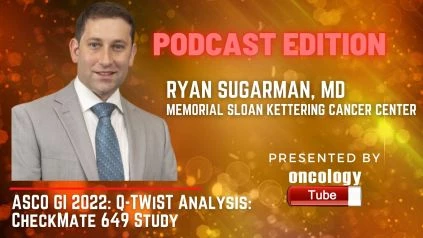Ryan Sugarman, MD, Strategic Partnerships Medical Director, Divison of Solid Tumor Oncology, and Assistant Attending of the Gastrointestinal Medical Oncology Service at Memorial Sloan Kettering Cancer Center. In this video, he speaks about the ASCO GI 2022 Abstract – A quality-adjusted time without symptoms or toxicity (Q-TWiST) analysis of patients in CheckMate 649: Nivolumab plus chemotherapy versus chemotherapy as first-line treatment for advanced gastric cancer/gastroesophageal junction cancer/esophageal adenocarcinoma (GC/GEJC/EAC).
Origins:
Patients who received nivolumab with chemotherapy (NIVO + chemo) had better overall survival (OS), progression-free survival (PFS), and maintained their HRQOL for longer in CheckMate 649 (CM 649), a randomized phase 3 trial of first-line treatment for advanced GC/GEJC/EAC. To assess the net benefits of NIVO + chemo vs chemo alone, we merged effectiveness and HRQOL data from CM-649 into a single metric, quality-adjusted time without symptoms of disease progression or toxicity (Q-TWiST).
Methodologies:
Time with grade 3/4 toxicity after randomization and before progression (TOX), time without symptoms of disease progression or toxicity (TWiST), and time from relapse or progression until death (TWiST) were used to divide OS into three health states in this study (ie, relapse, REL). The mean Q-TWiST was calculated by multiplying the duration of each state by its utility (U) (U[TWiST], 1.0; U[TOX], 0.5; U[REL], 0.5). Based on established clinical importance thresholds in existing Q-TWiST literature, relative Q-TWiST increases of 10% and 15% (measured as Q-TWiST difference divided by chemo alone OS) were regarded as clinically important and clearly clinically relevant, respectively. Patients whose tumors expressed PD-L1 CPS 5 and all randomized patients had their Q-TWiST differences calculated independently. The TOX and REL utility values were varied between 0 and 1 in a threshold utility study to determine Q-TWiST differences.
Findings:
Treatment with NIVO plus chemo was associated with a Q-TWiST improvement of 2.8 months (95 percent CI 1.0-3.7; relative gain 20.6 percent [clearly clinically important]) in patients with PD-L1 CPS 5, and 1.8 months (95 percent CI 0.9-2.7; relative gain 12.7 percent [clinically important]) in all randomized patients, when compared to chemo alone. Treatment with NIVO + chemo was linked with statistically significant Q-TWiST improvements exceeding minimum clinically meaningful differences across the complete range of TOX and REL utility values when compared to chemo alone, according to threshold analyses.
Outcomes:
In CM-649, NIVO with chemo significantly improved quality-adjusted survival compared to chemo alone in previously untreated patients with GC/GEJC/EAC. Longer periods of time without symptoms of disease progression or toxicity (TWiST) were related to statistically significant and clinically meaningful Q-TWiST gains when NIVO + chemo was used. These Q-TWiST findings add to our understanding of the benefits of NIVO + chemo versus chemo alone in terms of survival and quality of life and may help physicians and patients make management decisions for this patient population.

